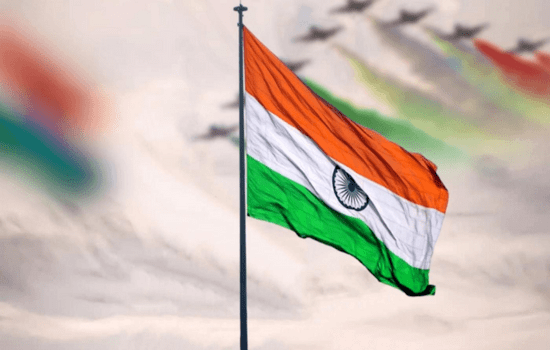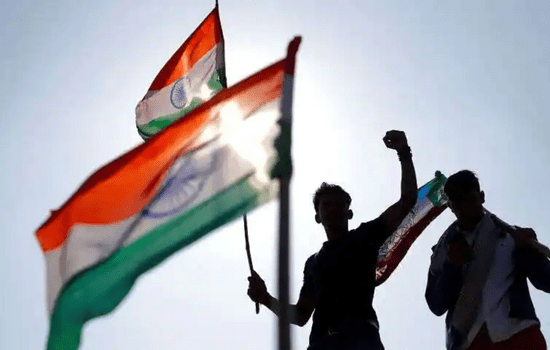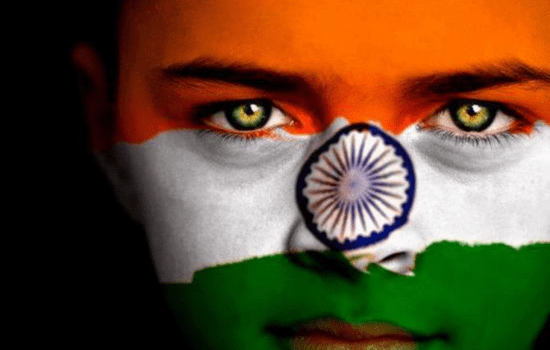Tiranga the Indian national flag has three different colors. All the three colors in these flags show the Indian people’s unity in diversity. It sets standards for how private, public and governmental institutions must fly the national flag. India’s Flag Code became valid on January 26, 2002.
Gandhi presented the Indian National Congress with a flag for the first time in 1921. Pingali Venkayya designed the flag. According to legend, Sister Nivedita, a follower of Swami Vivekananda, created the Indian flag for the first time in 1904. Red and yellow make comprised the flag’s two colors. Moreover, The center of it had a “Vajra,” which is thought to be Lord Vishnu’s weapon.
On August 15, 1947, at the Independence Day event at Red Fort in New Delhi, India, Jawaharlal Nehru salutes the flag as he assumes the position of the first prime minister of an independent India. The Indian national flag refers to the “tricolor” in that country. India’s national flag is a horizontal tricolor with equal amounts of deep saffron (Kesari) at the top, white in the middle, and dark green at the bottom. The flag’s width to length ratio is two to three.
History of Tiranga

Every independent country has its own flags which indicate its uniqueness and give a symbol of a free country. A few days before India’s independence from the British on August 15, 1947, the Constituent Assembly meeting on July 22, 1947, saw the adoption of the National Flag of India in its present form. Between 15 August 1947 and 26 January 1950, it served as the national flag of the Dominion of India, and then the Republic of India. Although, The Indian national flag refers to the “tricolor” in that country.
Now Tiranga consists of three colors. At the top of the flag, it has saffron( Kesari), the Middle part is of white color, and At the bottom area, it has dark green color. However, The length-to-breath ratio of Tiranga is 2 to 3. The white area also contains the Wheel which is the Ashok chakra. It has 24 spokes which indicate the continued hard work of people.
How Tiranga finally Selected as Indian National Flag
Before the year 2002 Tiranga was not the National flag of India. After the year of independency Indians allow to own their own flag and hoist them proudly. At that time we had another flag that was also hoisted at that time. But when time passes we connected to each other more and are also able to know the real potential of our country we think to modify our Flag.
Tiranga is the result of that effort and hard work. All the color and pattern has a specific meaning and a specific moral. Moreover, Like the top saffron is denoting pride, power, and courage. Whereas the Middle white one is for the piece and truth. Here one chakra is also there which is indicating the continuous efforts of Citizens towards the development of the country. The bottom Dark green is indicating fertility, growth, and hopeful land.
Tiranga Symbolizes
Tiranga Symbolises the aspirations and hopes of the Indian people. It stands for our sense of pride in our country. For the past 50 years, a number of people, including military personnel, have selflessly sacrificed their lives to maintain the tricolor flying in all its beauty.
Har Ghar Tiranga

Har Ghar Tiranga is a campaign that is running under the supervision of “Azad Ka Amrit Mahotsav” the purpose of this campaign is to encourage the people to the rise of National Flag of India in their houses in order to promote a sense of nationalism in heart of people’s and remember the great and difficult past for our nation.
To remember those who bravely fought for making the nation free and United. The government was expecting that all the residents of our country should hoist the Tiranga in their houses in the time period between 13-15 August. In light of the following, the objective should be to vigorously encourage hoist The Tiranga on their rooftops. However, To show the subject “Har Ghar” to express respect towards our freedom fighters and national heroes.
To mark the important occasion, you should hoist the flag in your homes from the 13th to the 15th of August. Apart from this, you can also pin a virtual flag on the website which is run by the government. However, You can pin the flag virtually by uploading your selfie on the site. So many celebrities like “AMITABH BACHCHAN, RAJINIKANTH, ANUPAM KHER” and so many others have already uploaded their selfie on the site. Where You can also upload yours.
Also Read: Independence Day of India: History & Celebration
Manufacturing of the Indian National flag

The design process of fir the National flag control by three documents The Bureau of Indian standards (BIS) issued this. All flags are made of khadi cloth and silk or cotton. However, there are only Nine standards size of our flags according to our law.
The khadi for the manufacturing of our flag is mainly obtained from two handloom units in the Dharwad and Bagalkot districts of northern Karnataka. Although, The only licensed production and supply unit of our national flag in India is Karnataka Khadi Gramodyoga Samyukta Sangha based in Hubli.
Interesting Facts about Tiranga

- Indian Freedom Fighter “Pingali Venkayya” designed the Tiranga. He belongs from Andhra Pradesh.
- The Cloth used to make the Indian Flag was Khadi which is hand-spun wool/cotton/silk Khadi Cloth. Only one organization in India has the authorization to provide and manufacture the Indian flag, and that organization is Karnataka Khadi Gramodyoga Samyukta Sangha.
- The Indian flag, the National Flag of the United Kingdom of Great Britain and Northern Ireland, and the National Flag of Nepal were hoisted on Mount Everest on May 29, 1953, after Edmund Hillary and Sherpa Tenzing Norgay’s ascent of the mountain.
- The Indo-Pak Attari Border saw the largest Indian flag raised. The biggest flag in the country is 110 meters long, 24 meters wide, and 55 tonnes heavy.
- The manufacturing rights to produce the Indian National Flag belong to the Khadi Development and Village Industries Commission.
- Tiranga has three colors which indicate: Top Saffron color- Sacrifice, courage, In middle white- For peace, purity, and truth, At Bottom dark green- For prosperity, The blue wheel at the center- For laws and continuous hard work
- Ashoka chakra symbolizes the Dharma. The Flag code did not specify the Asoka Chakra’s size. There should be 24 spokes (evenly space) on the Asoka Chakra. The Asoka Chakra is on the white strip of the flag in the color navy blue.
- The national flag of India has a width to length ratio of 2:3. The width and length of the three flag stripes should match.
- On July 22, 1947, soon before India gained independence from the British Empire, the Indian flag was recognized.
Also Read: Agneepath-You Must Know Everything About
Conclusion
Tiranga is not only the flag, but also the pride and love of all the Indians. Although Tiranga is not in the hands all the time of everyone but this is always in the heart of Indians. The moment when Our national flag is hoisted alongside our national anthem gives delight and pride to everyone’s heart. Automatically the eyes are seeing the sky and say thanks to god for an independent nation.




